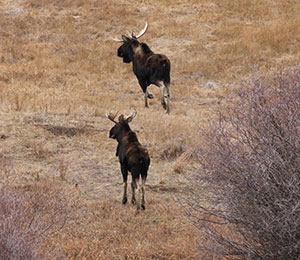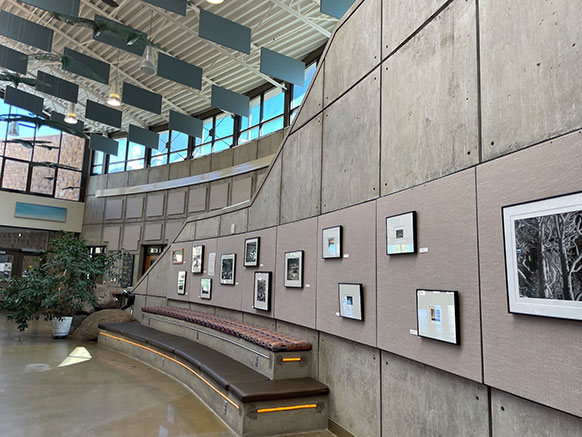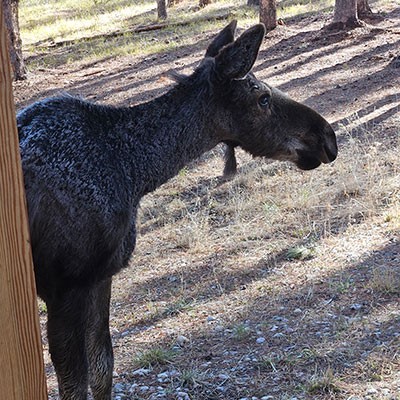No Slides Entered.
Winter Moose Day Weekend Planned For Feb. 8-9
For those who have a little bit of patience and love wildlife, looking for moose in the areas surrounding Laramie may qualify as a desirable winter outdoor excursion.
For the 11th year in a row, community scientists will be called upon to help spot and count moose populations in the mountains outside of Laramie for Winter Moose Day weekend. Coordinated, in part, by the University of Wyoming’s Biodiversity Institute, the event is scheduled Saturday-Sunday, Feb. 8-9, in the Vedauwoo/Happy Jack, Snowy Range Mountain and Arlington areas. Registration opened Thursday, Jan. 2, with the deadline to register Sunday, Feb. 2. To register, go here.
“The data collected during Winter Moose Day is used to estimate detectability of moose by human surveyors. Despite being the largest member of the deer family, they can often be hard to spot among the trees. This is important for population estimates for conservation and management,” says Mason Lee, senior project coordinator for the Biodiversity Institute. “But, more than that, Winter Moose Day is just a fun excuse to enjoy a crisp winter morning in our national forests with your friends and family, all while contributing to science.”
As in past years, volunteers will adopt survey routes and ski or snowshoe those routes to chart all observations of moose or signs of moose. These can include tracks/hoof prints in snow, bed areas, scat droppings, and browse on aspen and willows. To survey while moose are most active, participants are asked to get to their routes as early as dawn and to complete their surveys by noon.
The 2024 event drew 92 surveyors who made up 40 different survey groups that covered 26 of the available 30 observation routes. The same number of routes are available each year. These include 17 in Pole Mountain, 12 in the Snowies and one in the Arlington area.
In 2023, protocol was changed to allow multiple groups to independently survey the same route. While this means there is a possibility that Moose Day surveyors may encounter other Moose Day survey groups on their routes, the upside is that multiple independent surveys help the Biodiversity Institute better estimate detection probability of moose and moose signs.
“Despite how large moose are, they’re really good at hiding,” Lee continues. “So, just because an observer doesn’t report seeing a moose doesn’t mean the moose wasn’t there. Having multiple groups allows us to correct for this potential underestimation.”
Winter Moose Day is often marked by strong winds and/or snowfall, both of which can obscure or hide fresh tracks and other signs of moose, Lee says. This can result in few sightings of moose signs. Volunteers are encouraged to collect weather and visibility information on their routes.
Ideally, there would be at least one volunteer group to cover each of the 30 routes, Lee says. But, because some of the routes are more difficult to traverse than others or are farther away, all routes do not usually get adopted.
For safety reasons, survey groups should consist of at least two people. Groups can be as large as people decide, Lee says. When groups record their data on Moose Day, it is important to provide the number of people who were in the group to account for effort in the detection probability estimates, Lee adds.
Because multiple groups can register to survey the same route, a lot more people can participate in Moose Day than in previous years, says Lee, who adds the surveyors are typically a mix of volunteers who participate annually as well as newcomers.
While observations of moose can still be voluntarily loaded into iNaturalist for public viewing, Lee says the Biodiversity Institute is no longer creating Moose Day projects on the website, a joint initiative of the California Academy of Sciences and the National Geographic Society.
Training will be conducted a few days before Moose Day, but an exact date, time and location have yet to be determined. Information will be available when people register, Lee says. Training includes a one-hour classroom session and a one-hour outside training component.
“The training is required of new participants,” Lee says. “If they are unable to attend the in-person training, we will have a recording and quiz that they must take before receiving their materials.”
Data gathered from Winter Moose Day is shared with biologists at UW. These biologists use the data collected by community scientists to further their understanding of the population densities of local moose, their reproductive rates, their winter ranges and how these variables change over time.
During the 2024 Winter Moose Day, 11 adult moose were observed (12 if you count one that was spotted as a surveyor drove to their site), and many signs of moose -- scat, tracks, etc. -- were seen, Lee says. A record 19 moose -- 15 adults and four calves -- were spotted during the 2022 Winter Moose Day.
As of December 2024, the Wyoming Game and Fish Department estimated there were 3,600-4,000 moose in Wyoming, with moose populations gradually increasing. The estimate is based on surveys conducted annually by the department.
Both the winter and summer Moose Day events are geared toward increasing the public’s understanding of moose in the Laramie area and involving the public in asking and answering questions. These events are an extension of the original program, Moose Day, held by Nature Mapping Jackson Hole (NMJH) in Jackson each winter. NMJH is a citizen-science program created by the Jackson Hole Wildlife Foundation.
Share This Post

This photo shows two moose spotted in northern Colorado in October, near where moose were introduced that eventually made their way into the Laramie area.
Social Media
Latest News



Archives
- All
- October 2025
- August 2025
- July 2025
- June 2025
- May 2025
- April 2025
- March 2025
- February 2025
- January 2025
- November 2024
- October 2024
- September 2024
- August 2024
- July 2024
- June 2024
- May 2024
- April 2024
- March 2024
- February 2024
- January 2024
- December 2023
- November 2023
- August 2023
- July 2023
- April 2023
- September 2022
- August 2022
- July 2022
- June 2022
- May 2022
- April 2022
- March 2022
- February 2022
- January 2022
- December 2021
- November 2021
- October 2021
- September 2021
- August 2021
- May 2021
- April 2021
- March 2021
- October 2020
- August 2020
- July 2020
- January 2020
- March 2019

